What are electric bikes (group review of five models of two manufacturers), part 2
In this part we will look at three models of electric bikes "for lazy" users. These bikes are so classified for being able to move fully on the power of the motor, without any effort by the cyclist (although it is not forbidden to apply your own power).
The first part of the review was published here .
Electric bicycles will be considered in descending order of "solidity" of models:
')
Traditional note: Twitter electric bikes have nothing to do with the social network Twitter.
The model is a powerful (350 W) electric bicycle with a capacious battery (480 Watt-hours, 48 V * 10 Ah).
Because of its high power, like the Twitter electric bike Mantis-E1, discussed in the first part of the review , according to the classification of traffic regulations, it refers to electric scooters. But it did not affect the appearance.
Let's look at it in general (right and left):


Before further narration, let us familiarize with the main technical parameters of the electric bike:
Wheels - 26 ", double piston rim
Bicycle weight - 19.8 kg
Frame - aluminum, 17 "
Fork - aluminum, damper with the ability to lock.
Gearshifts - Shimano Altus, 27 speeds, (9 * 3)
Brakes - hydraulic disc, Shimano Tourney, mechanical
Tires - Kenda, 26 "× 1.95"
Modes of use - scooter mode, help mode, pedal mode
Drive Parameters:
Number of help mode levels - 5
Battery - Removable, 48 Volt, 10 Amp-hours
Motor - rear wheel motor, brushless, 350 W
Maximum speed - 35 km / h
Mileage on a single charge - 40 km (scooter mode), 120 km (help mode)
Dashboard - LCD Display
Fully all parameters - on the official page of the specifications of the bike .
Bicycle price - 64990 rubles. This price is significantly lower than the more sophisticated Twitter electric bikes discussed in the first part of the review.
This is explained by the more “simple” components on which this bike is built: most of them belong to the initial class of mountain bikes.
At the same time, the electric drive of this bike is no weaker than that of the more expensive models mentioned above. By the way, as mentioned above, according to the traffic regulations, for its high power (> 250 W) it falls into the category of electropaths; although from the side and did not think so.
Let's look at the central part of the bike with a saddle:
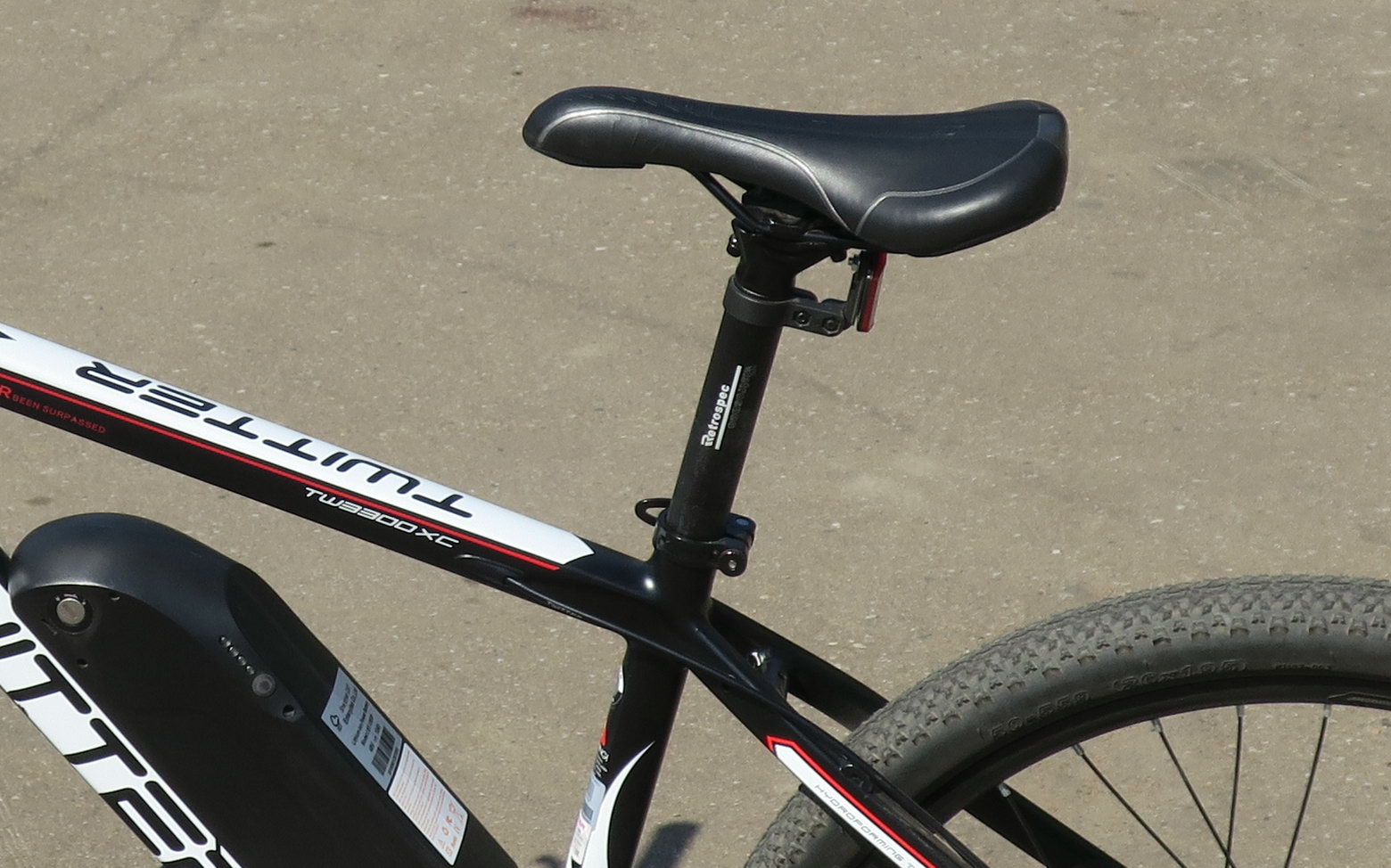
The joints of the frame parts between them are smooth, without welds characteristic for welding. The manufacturer calls this “seamless welding” when the traces of welding are carefully smoothed out and become completely invisible.
Saddle - moderately hard, close to sports. You can get used to it.
One of the features of the layout of the electric bike is the separate blocks of batteries and controllers:
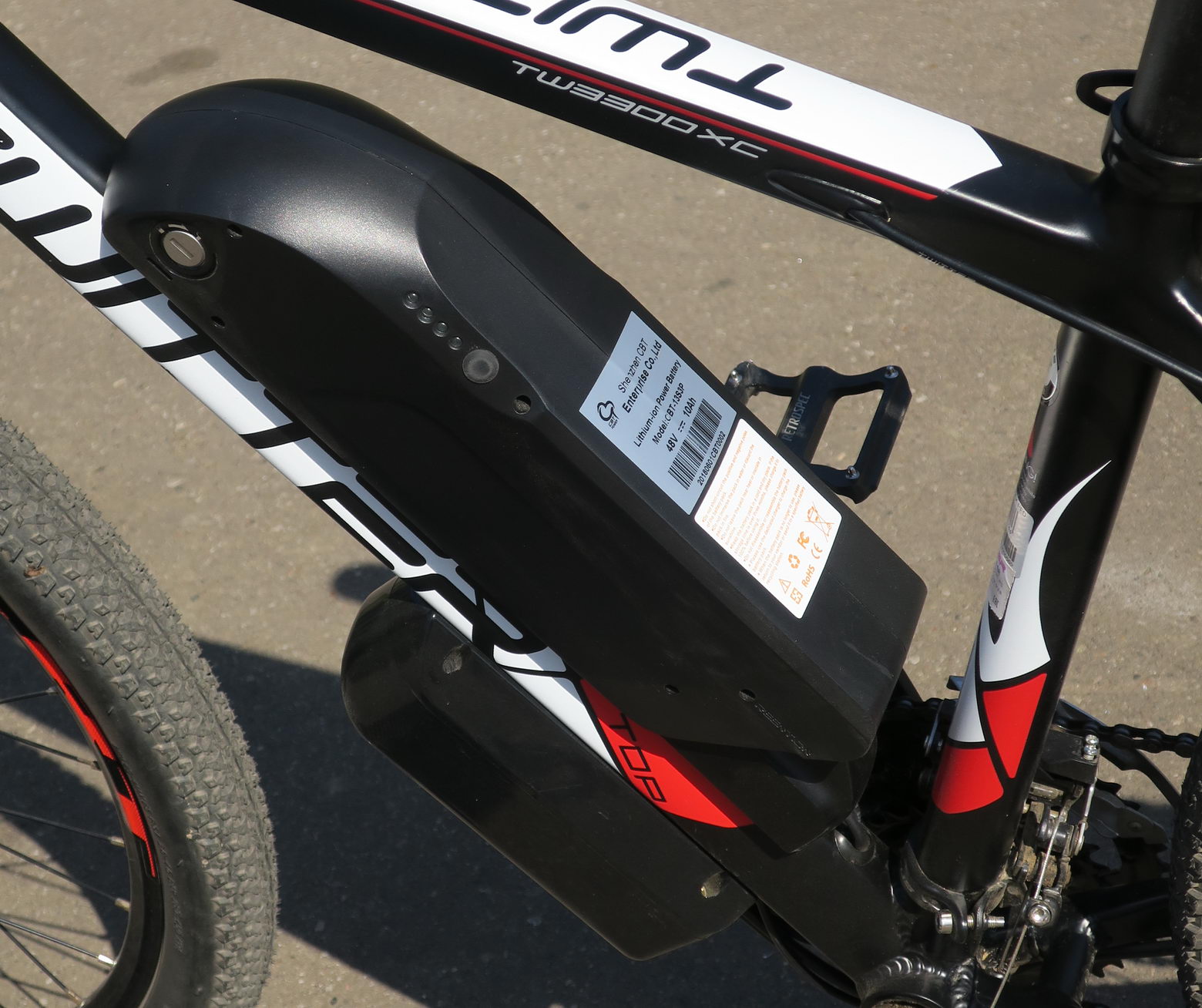
The top unit in the photo is a battery (with its own charge controller); and the lower unit (under the frame) is the control unit that controls the electric bike motor.
Due to the fact that the battery pack is removable, it can be charged separately from the bike (the bike can be put in one room and the battery charged in the other).
We will look at the steering wheel of an electric bike in two angles, right and left:
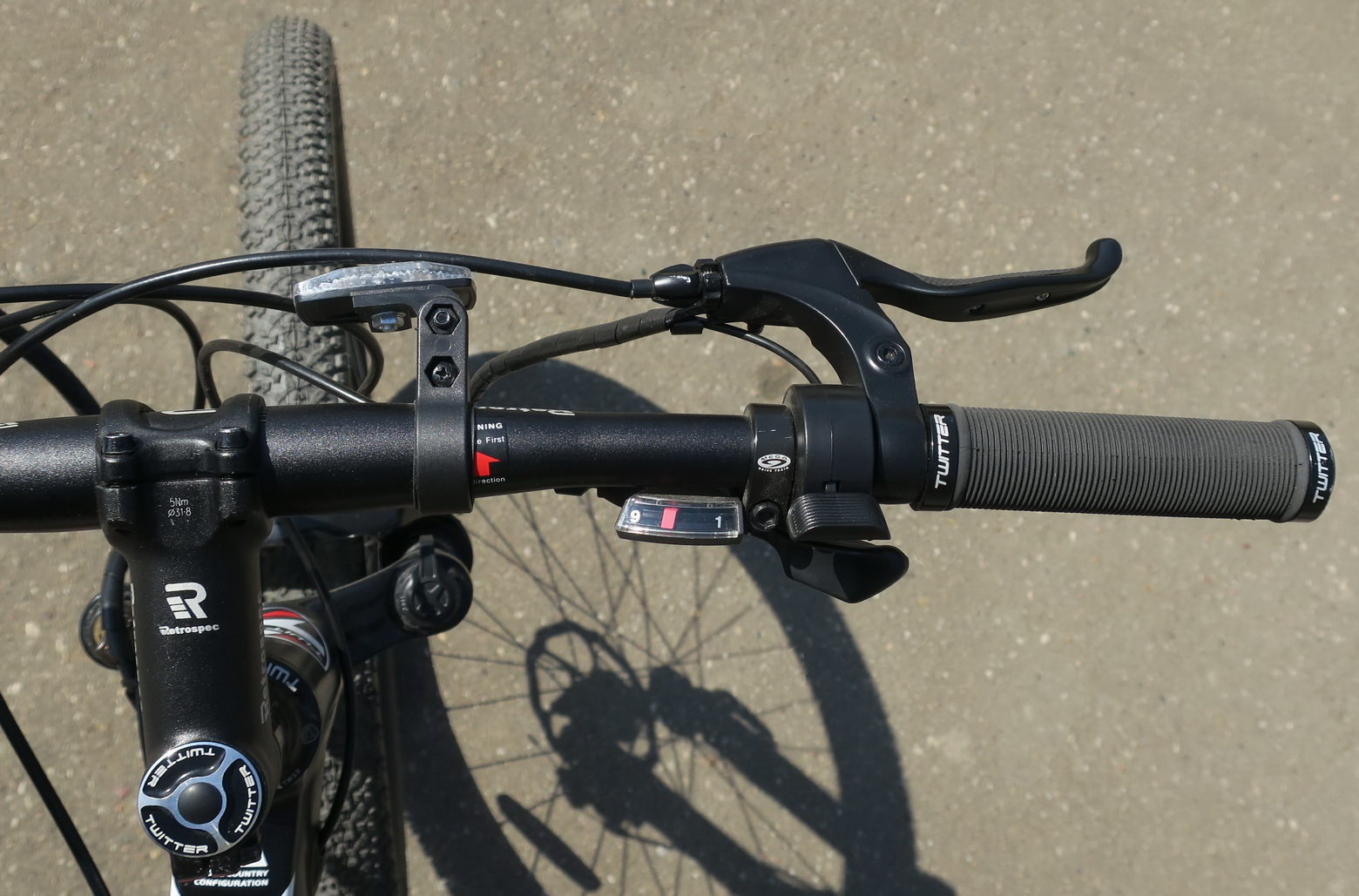
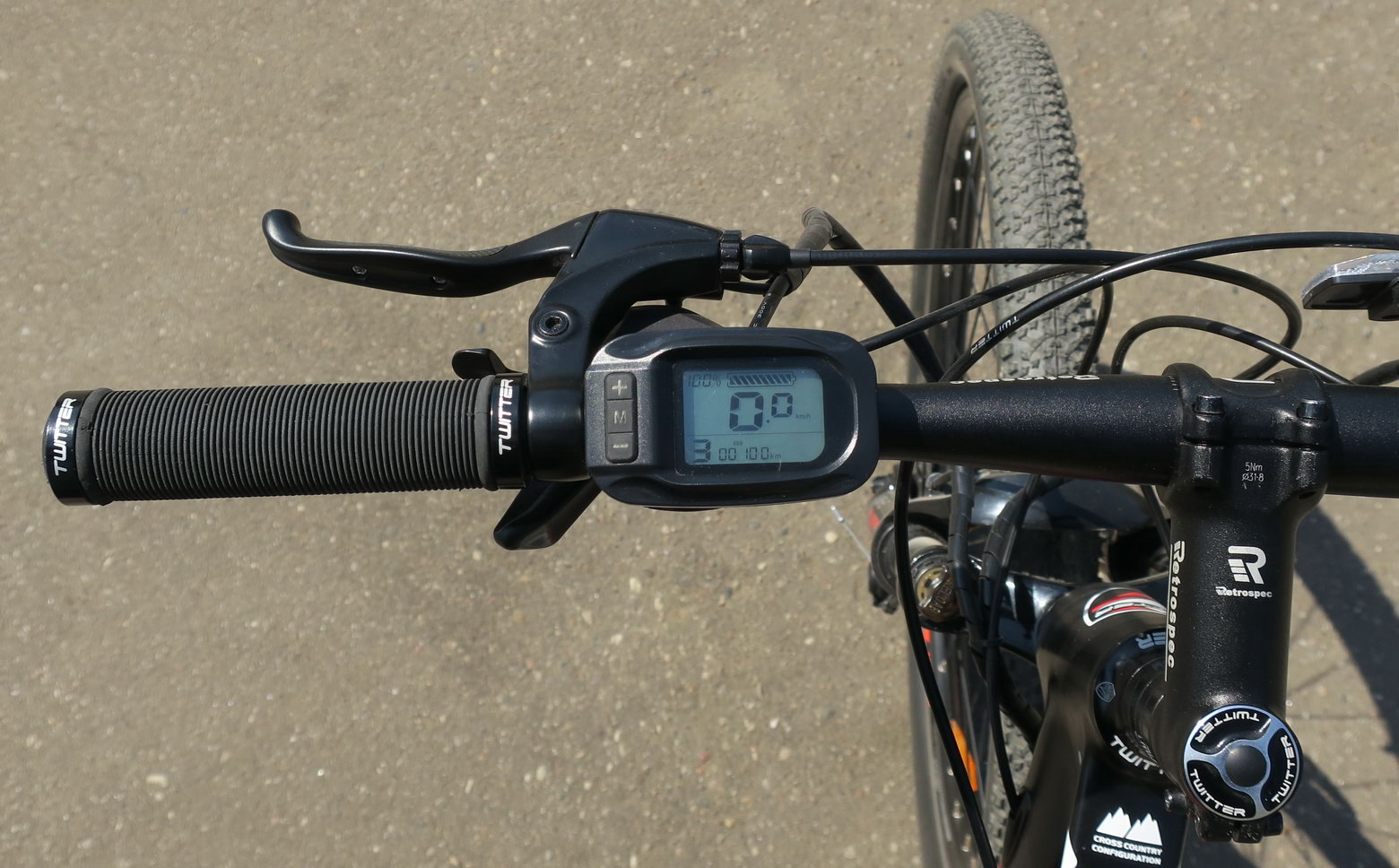
On the right side of the steering wheel, among other things, there is an electric motor power lever. It works smoothly: the more you move it, the more power is supplied to the electric motor, but within the level of assistance that is set by the user.
Thus, the user-defined level of assistance simultaneously controls two characteristics: the actual level of assistance from the motor to the cyclist (when he pedals), and the maximum power level supplied to the motor when the user forcibly turns on the motor (but does not pedal).
On the left side of the steering wheel there is a cycling computer with an LCD screen, combined with a bicycle control panel of three buttons. It sets the level of assistance (from 1 to 5 - "combat" levels, zero level - pedaling without turning on the motor), and also changes the information display modes.
The speed of the electric bike and the battery charge are always displayed; and you can also set the display of the length of the current trip, its duration, or odometer (total mileage).
Look at the front wheel and its fork:

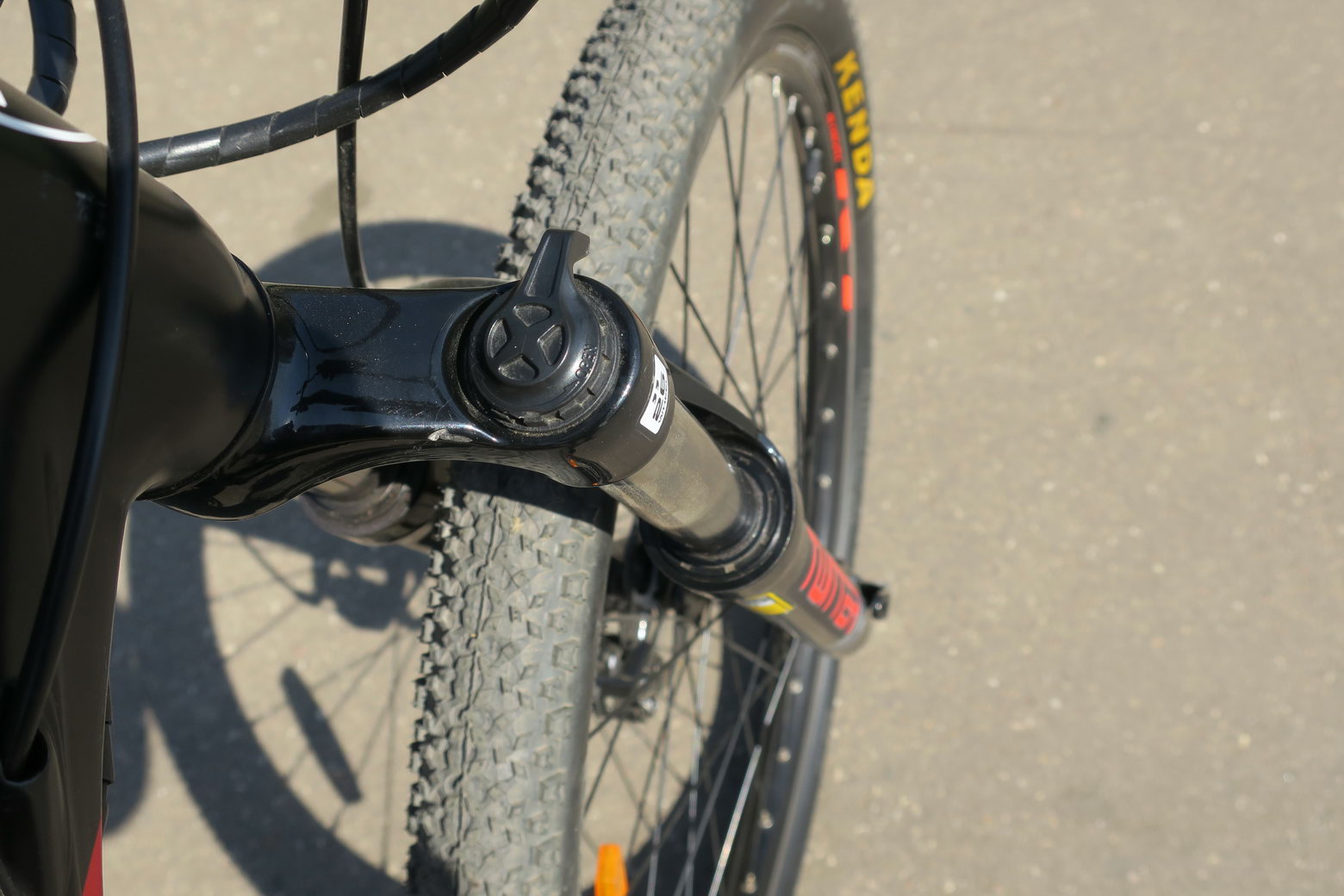
Wheels - universal type, designed for asphalt and ordinary soils (without sand or wet clay).
Accordingly, the brakes, too, although disc, but not from the "cool."
The plug is with a simple damper that is either “on” or “off” (i.e., the plug is fixed). Fork stroke - 100 mm.
The rear wheel of a bicycle is made in the form of a widespread motor-wheel. The motor itself is rather small for its power, and from the side it does not “catch the eye”:
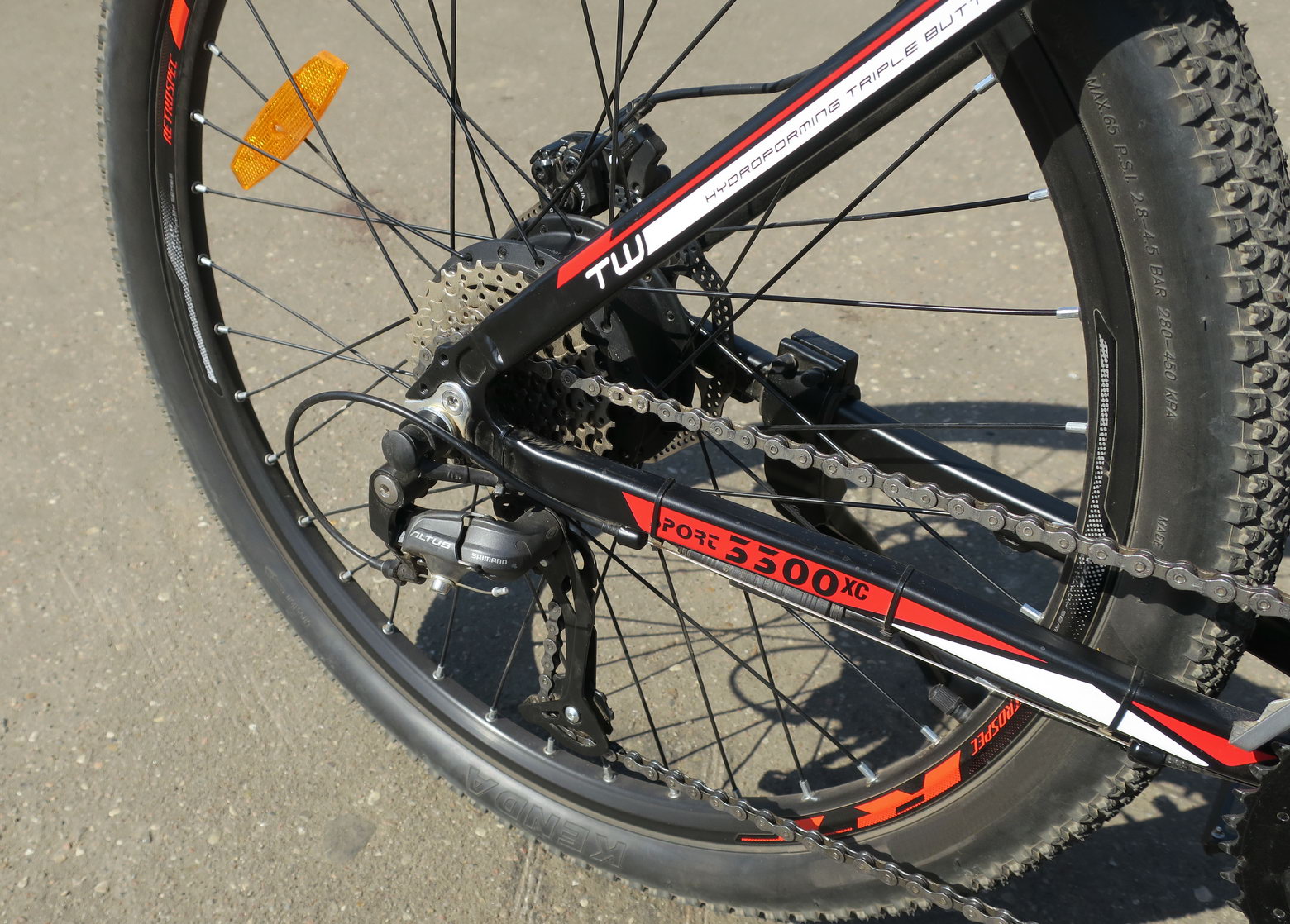
All brakes and speed switches are entry level for mountain bikes.
And finally the pedals. The pedals here are aluminum, thin. They hold the leg well due to the “evil” spike construction:
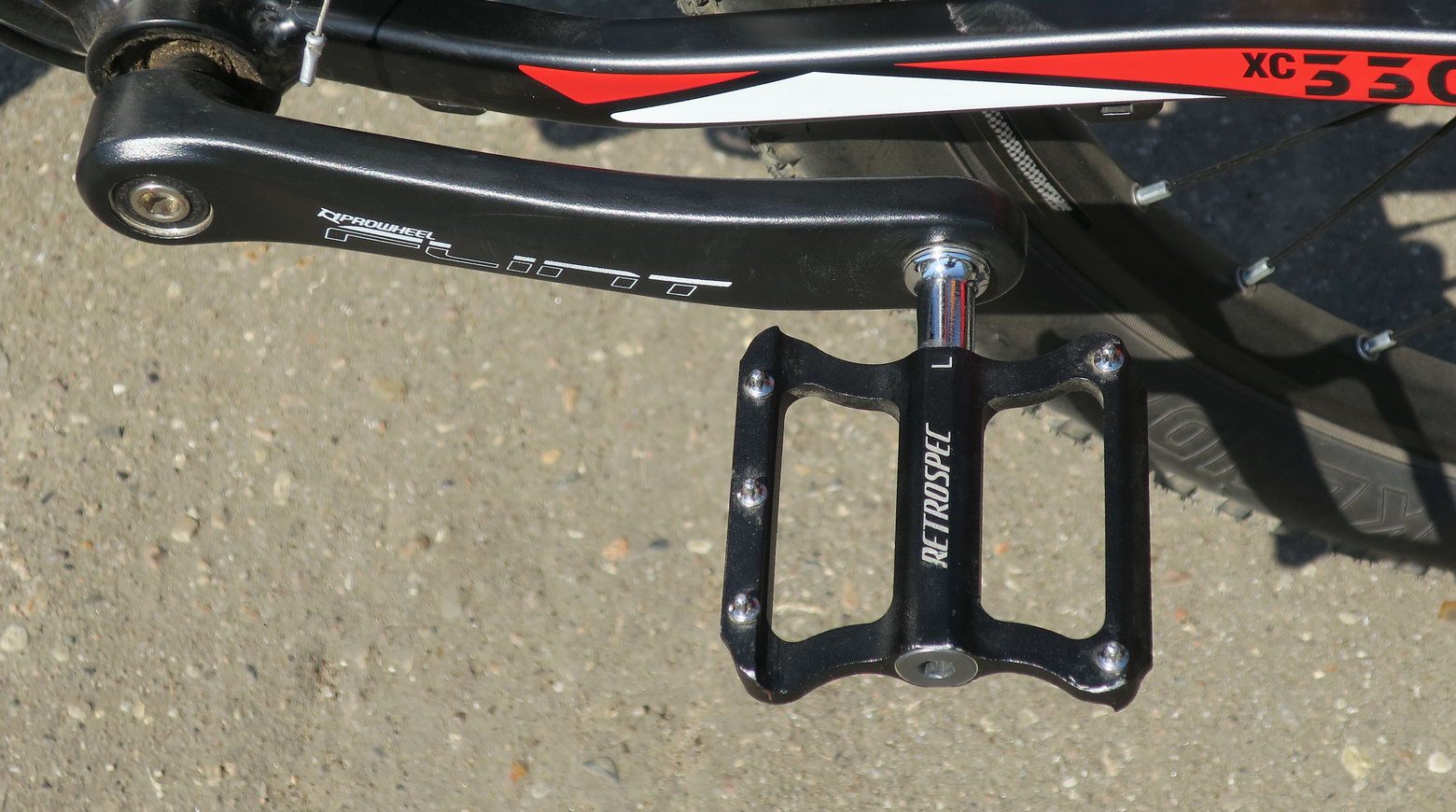
On the pedals are pins with a rounded top. Despite the fact that the tops are rounded, if you touch the pedal with your foot, you can get hurt. Care must be taken when driving a bicycle next to you.
Electric performance Twitter VS7.0-ER
This electric bike is characterized by the greatest versatility of the modes - it can roll by the force of the motor, the force of the motor together with the power of the catalan, and, of course, only the force of the catalza.
In the help mode, the motor works in the same way as in many other bicycles: it helps the catalas until the power level reaches the limit for the set level of help. And then, if the katalec increases its strength, the power at the motor will decrease.
In this case, if the cyclist wants to go even faster with the help from the motor, then either he should increase the level of help on the console; or, if it was already the highest level of assistance, go skating on your own.
The most interesting question for electric bicycles with the ability to move in scooter mode (only on the motor) is the distance traveled in this mode. Even if such a regime is really rarely used (after all, on a bicycle you want to stretch your legs at least slightly), but such a test is of undoubted “scientific interest”.
So, pumping up the tires well (this increases the efficiency of the bike), I hit the road, choosing better roads (because with well-inflated tires it can be a little painful to drive on bad roads).
The result is just above 65 km (with only 40 km promised by the manufacturer).
The result is excellent, but it can strongly depend on many factors: tire inflation, road quality, weight of the rider and even the weather (headwinds will not contribute to the distance of the trip). Therefore, I will not be enthusiastic about this over measure, but, as a positive fact, I will note.
As for the distance of the trip in mixed mode (motor + legs), there is no doubt about the 120 km indicated by the manufacturer (provided that the cyclist takes up at least 50% of the effort).
A separate question is about speed.
It is possible to achieve the 35 km / h promised by the manufacturer without any efforts (on the motor alone), but the speed can be increased only by our own efforts; and they will have to increase significantly with each additional kilometer of speed.
The number of disadvantages of a bicycle should again include a non-linear graph of battery consumption. At first, the monitor showed a lack of consumption for a long time (charge 100%), and only after a decent trip time did it start to show discharge.
Conclusions on the electric bike Twitter VS7.0-ER
1. The bike has high versatility: you can ride with comfort on the strength of the motor, without a motor, and in mixed mode (legs + motor). This flexibility makes the engine suitable for all lovers of movement on personal electric transport: you can always choose the proportion of application of your own forces, which is convenient for you. Or do not apply forces at all (if you are already tired and rolled).
In addition, the electric bike has a very affordable price for its capabilities.
2. The bike has a powerful motor and a very high range on a single charge. In this regard, it is recommended to use it for extended trips with good speed; and for trips through the parks, the possibilities of the bike will be exaggerated. Although this is not excluded.
We turn to the following models of electric bicycles, already from another manufacturer.
This model can also move autonomously, i.e. only the power of the motor; but the help mode and the usual pedal mode are also not excluded.
The main technical parameters of the electric bike:
Wheels - 26 ", double rim
Bicycle weight - 19.5 kg
Frame - Aluminum
Fork - tough
Gear selector (rear only) - Shimano Tourney, 7 speeds
Brakes - disc mechanical
Tires - CST
Modes of use - scooter mode, help mode, pedal mode
Drive Parameters:
Number of levels of help mode - 10
The number of motor power levels - 16
Battery - 36 volts, 162.8 / 214.6 W * h
Motor - motor-wheel, brushless, 235 W
Maximum speed - 27 km / h
Mileage on a single charge - 15-20 km (for 162.8 W * h), 20-25 km (for 214.8 W * h)
Dashboard - LCD Monitor
Fully all parameters - on the official page of the specifications of the bike .
Price - 43490 rubles for a model with a 162.8 Wh battery; 46490 rubles for a model with a battery of 214.6 W * h.
It was only possible to test the maximum model - with a battery of 214.6 Wh.
The appearance of the electric bike on the right and left:


There are unusual details in the design of an electric bike.
The unusual design of the main part of the frame is in the form of a triangular aluminum profile that is curved by a triangle; rear frame feathers are also unusual.
The lower frame feather is thickened, and, apparently, carries the main load.
The upper feather is thinner and is attached to the main frame with bolted joints.
The set of electric bikes already includes lighting - a headlight and a rear red beacon.
The beacon, when it is extinguished, looks like a normal passive reflector. But when it is on, it glows very brightly with several rows of LEDs.
In the center of the whole structure is the integrated battery-controller unit:
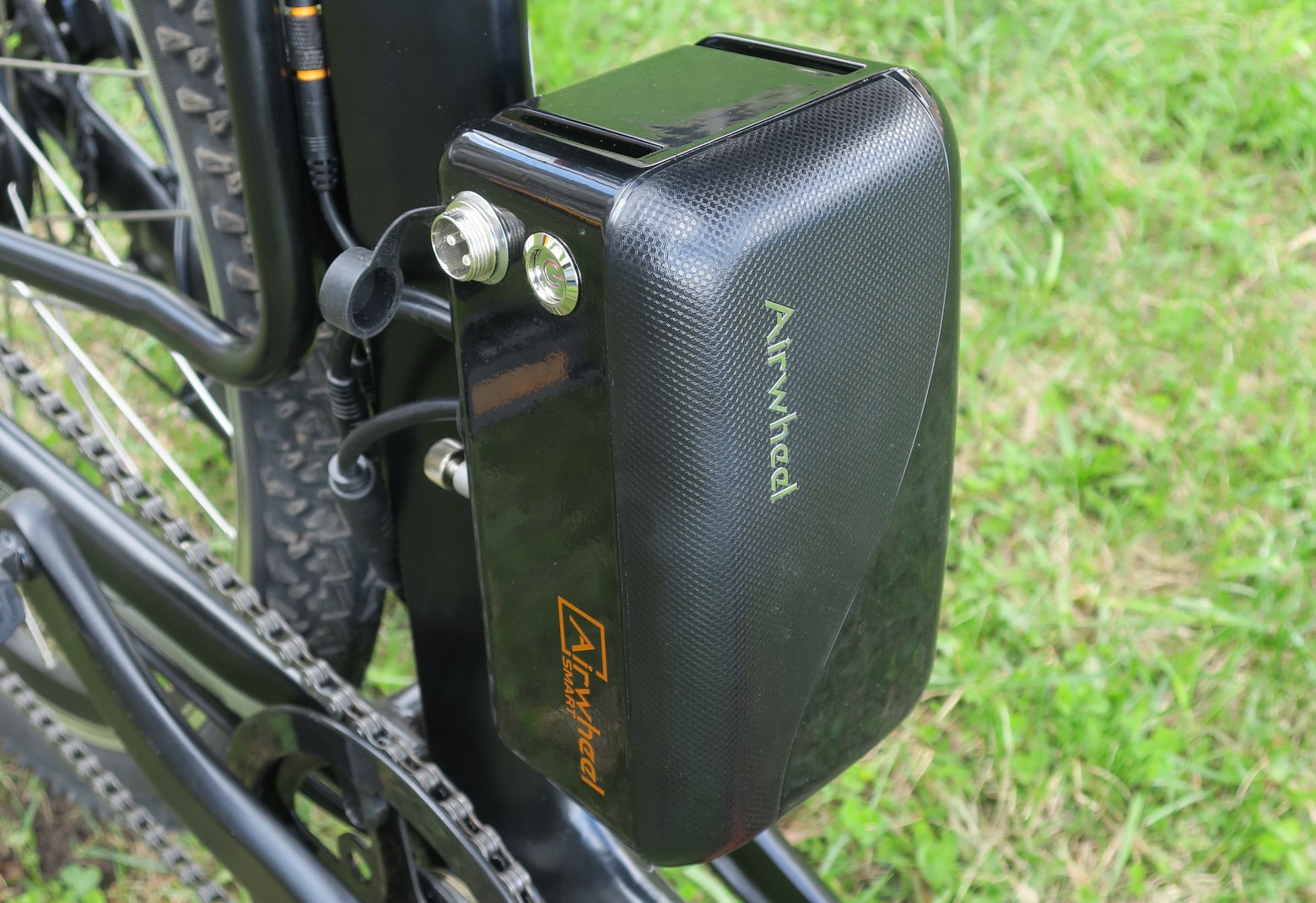
The photo shows the block from the side of the power button and charging connector. On the opposite side is the USB connector for charging the user's mobile devices from the bicycle battery.
The battery pack can be considered non-removable (although the manufacturer claims the opposite). You can remove it, but you have to disconnect too many connectors.
Of interest is the saddle:

Orange corrugation on the seatpost can be taken just for decoration. In fact, behind it lies a small damper, partially compensating for the lack of depreciation on the front wheel fork.
In the same photo, you can distinguish the tread pattern on the camera lid. This is a typical poluslik, when the tread in the middle is shallow (for asphalt), and higher on the sides (for soils).
Examine the steering wheel:
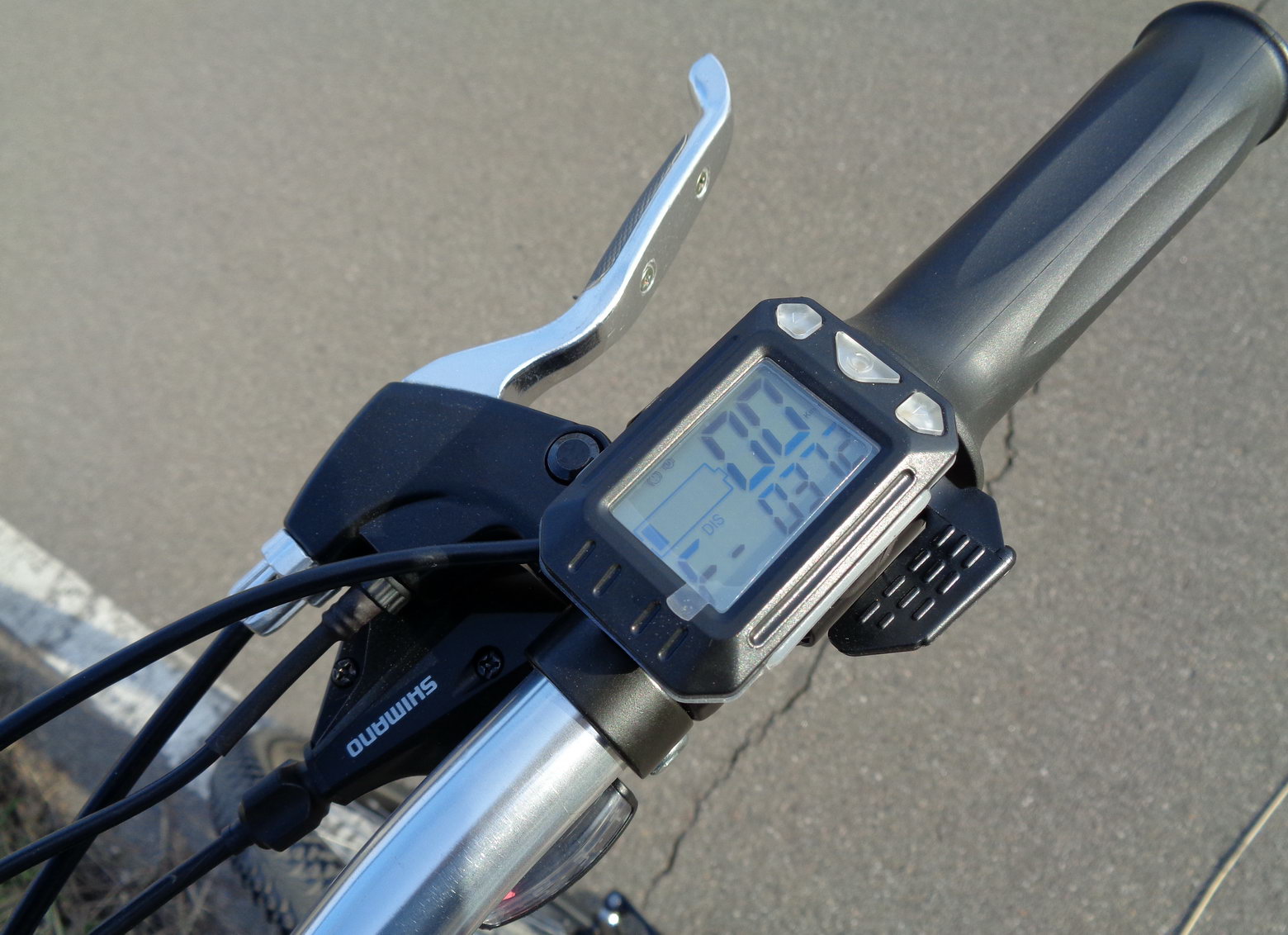

On the right side of the steering wheel, most bike controls are assembled.
Here we find the rear brake lever, speed selector lever, remote control with the cycle computer, and the lever for supplying power to the motor.
The left side is less functional, here is the front brake knob, the red light button and the green horn button.
The display shows the distance of the current trip, the current speed, battery charge and the set riding mode. If the assistance level is set to zero, then this is the pedal mode.
I really liked the lighting, but the beep didn’t really.
The loudness of the sound signal is normal, but the sound itself is a usual monotonous beep; and not very similar to the sound of various mechanical bicycle calls (which is confusing passersby - they do not understand what kind of object is coming from behind).
The speaker itself is installed in the same housing with the headlamp:
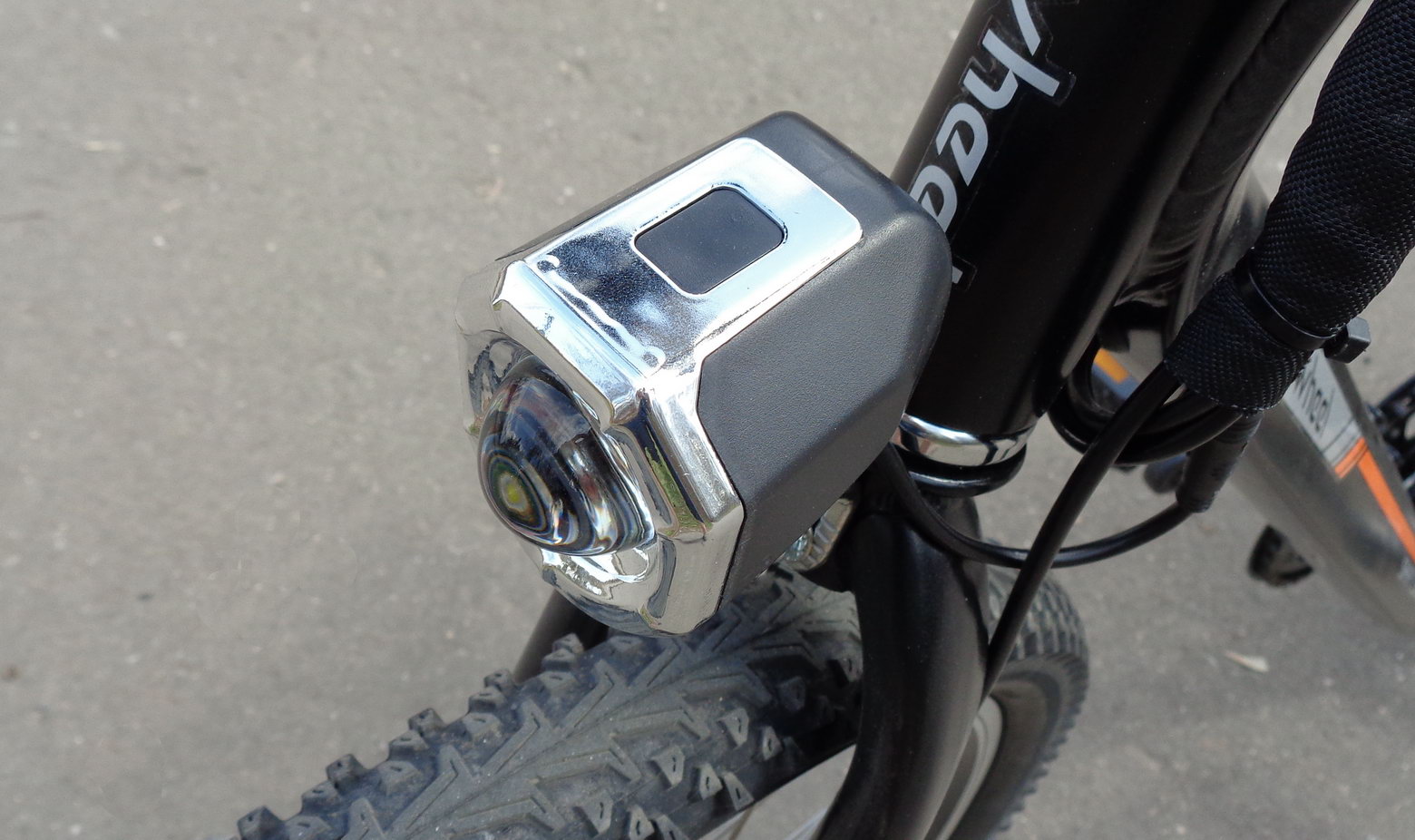
Holes for sound output from the speaker are located on the back of the headlamp.
The headlamp has a very convex lens that does not allow the light flux to “spread out” in all directions, and shines forward with an optimal angle of scattering.
By the way, the headlight is LED, as it is now accepted.
The front wheel is more than ordinary:
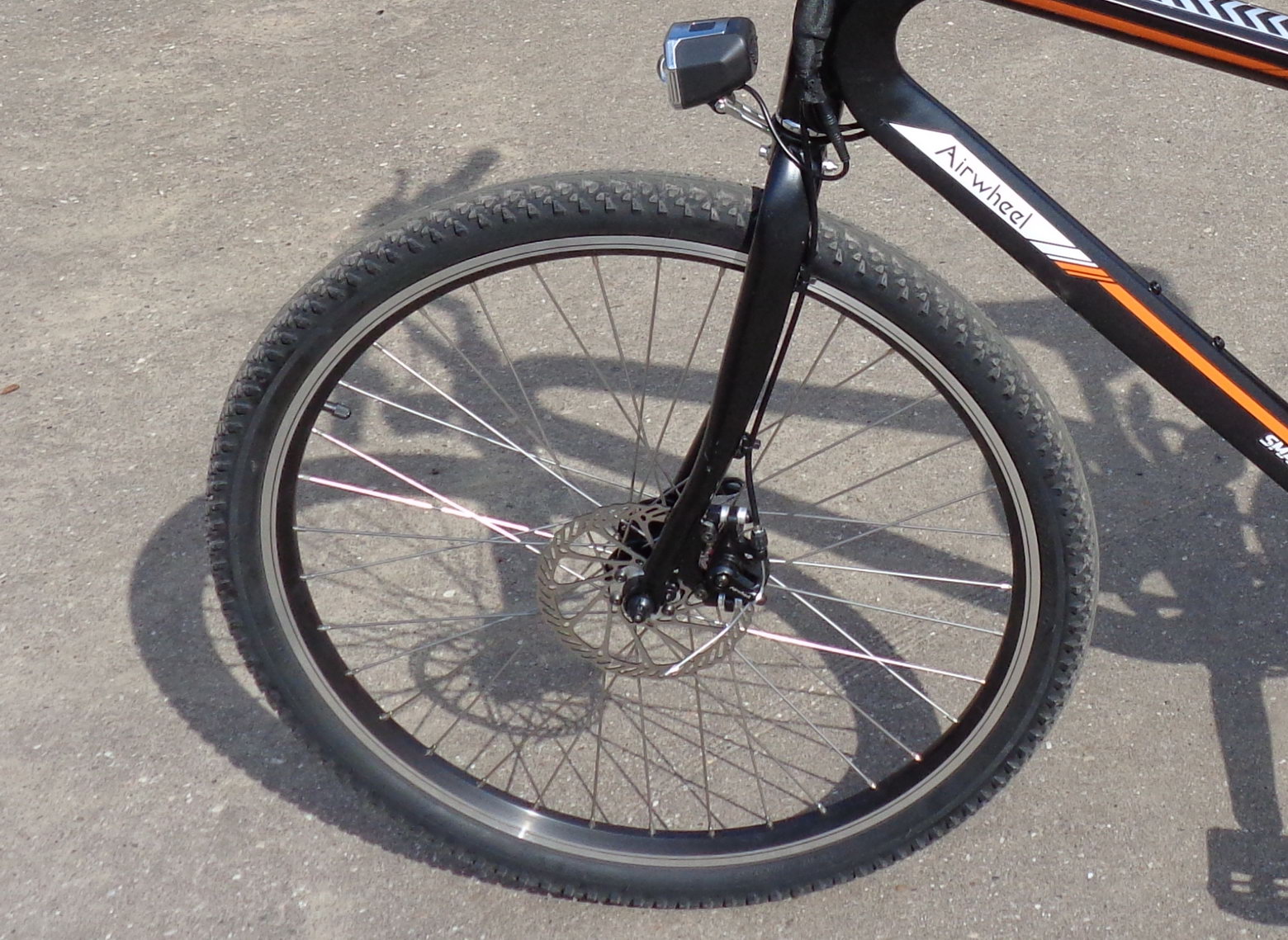
The disc brake is marked as “Airwheel”, so at least partially produced by the bicycle manufacturer itself.
The rear wheel is a traditional motor-wheel:

By the way, I had to tinker a bit with him (or rather, with the frame next to him).
In the test races it turned out that when jumping, even from small curbs, the chain hits the lower frame feather with an unpleasant sound. This problem is often found in different brands of bikes, and there is a standard solution: stick a rubber pad on the feather (it can be seen in the photo).
Before that, I applied the “people's solution” - I wrapped the bottom feather with a ribbon, but this turned out to be not aesthetic.
The last detail of this electric bike, which we will study, is the pedals. They are here - slightly spiny, plastic, but not simple, but folding:
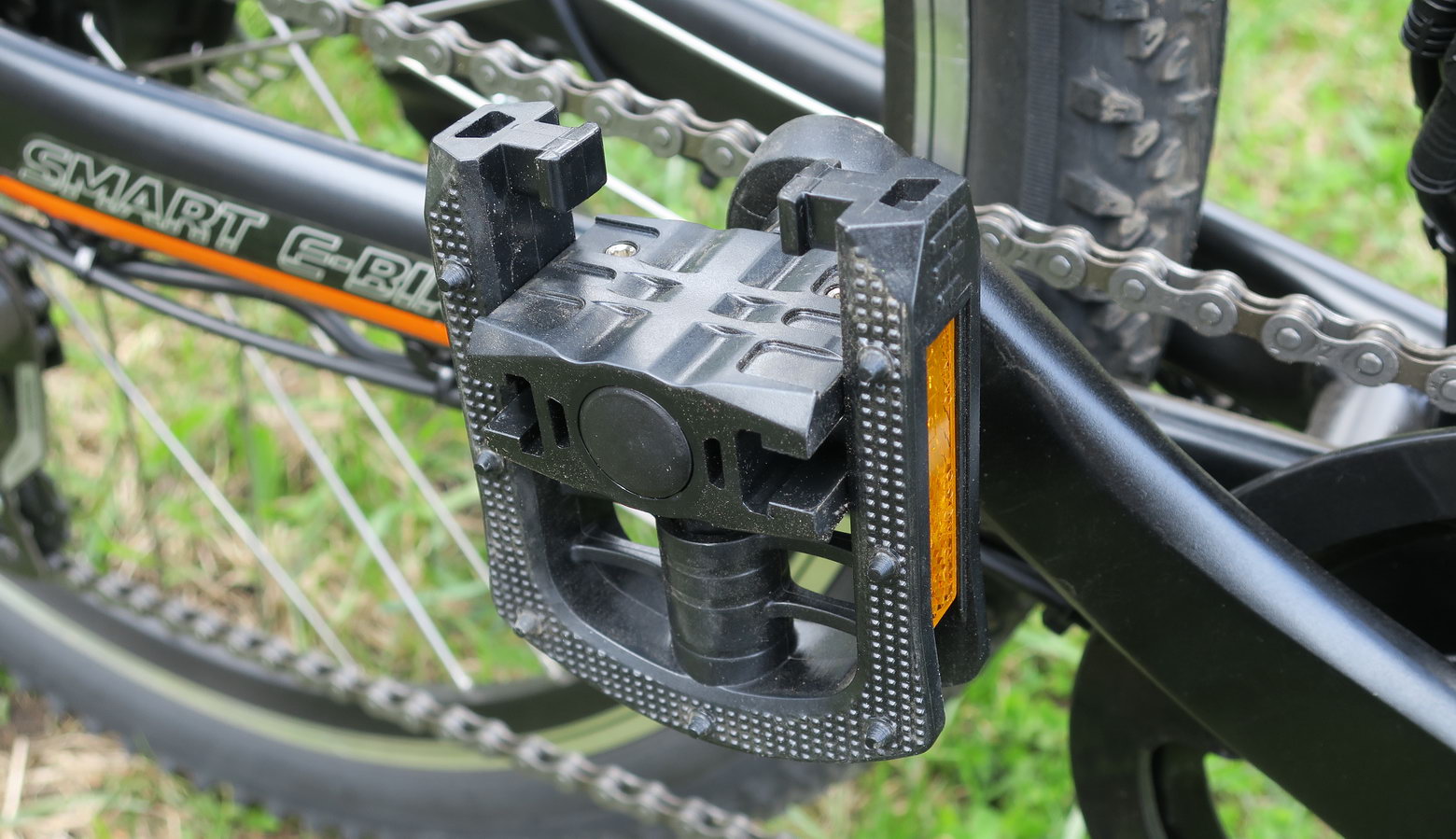
If the pedal is folded, it will help in some cases to reduce the space occupied by the bike in the room.
Road performance of the Airwheel R8
Formally, in this bike, the help mode and the mode of movement on the motor are separated. But this division turned out to be just formal.
In fact, when driving in help mode, it is possible to stop pedaling, and, by pressing the gas lever, ride only on the motor.
The reverse is also possible: in motor mode (in the manual it is called “moped mode”), pedals can be started; and, moreover, twist them for the benefit of the movement and to save battery consumption.
In any case, the motor will help the rider only until it reaches the maximum power for the set mode. And then you will provide all the extra speed on your own.
But it should be noted quite a big step between the highest and the penultimate stage of engine power.
At the penultimate level, you can accelerate, moving only by motor power, up to 20-22 km / h; and at the last (top) level - already up to 27-28 km / h. Perhaps this step is too big.
Were conducted and tests on the course using only the power of the engine, it was 37 km (the manufacturer was modest, saying in the characteristics of only 20-25 km). The tests were carried out, as always, on good roads, with well-inflated tires and at a speed of about 18-20 km / h.
Following the results of the inspection and test of the Airwheel R8, three conclusions can be drawn:
We turn to the next model manufacturer Airwheel.
If the previous two models of electric bicycles could be classified as “for the lazy”, then this model can be classified as for the “very lazy”. Why - will be explained further.
The main technical parameters of the electric bike:
Wheels - 14 ", cast, aluminum
Bicycle weight - 17 kg
Frame - aluminum, foldable, with shock absorption
The number of speeds - 1
Fork - tough
Brakes - disc mechanical
Modes of use - scooter mode, help mode, pedal mode
Drive Parameters:
Battery - 36 volts, / 214 W * h
Motor - motor-wheel, brushless, 235 W
Maximum speed - 20 km / h (25 km / h when setting the maximum in the application)
Mileage on a single charge –20-25 km
Dashboard - LED battery charge indicator
Software: application for Android and iOS.
Fully all parameters - on the official page of the specifications of the bike .
Price - 37490 rubles (in some stores may be more expensive).
The appearance of the electric bike on the right and left:
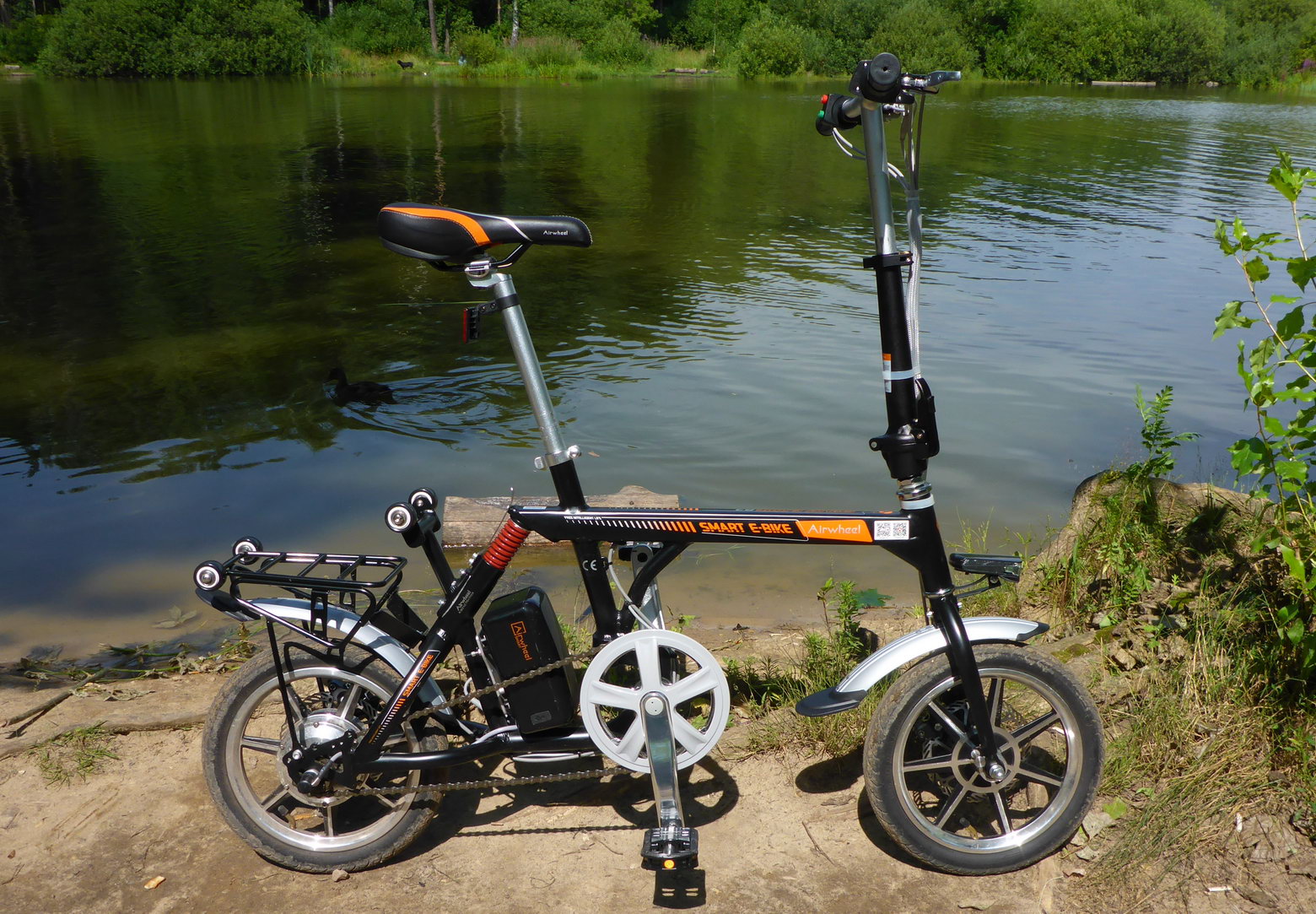
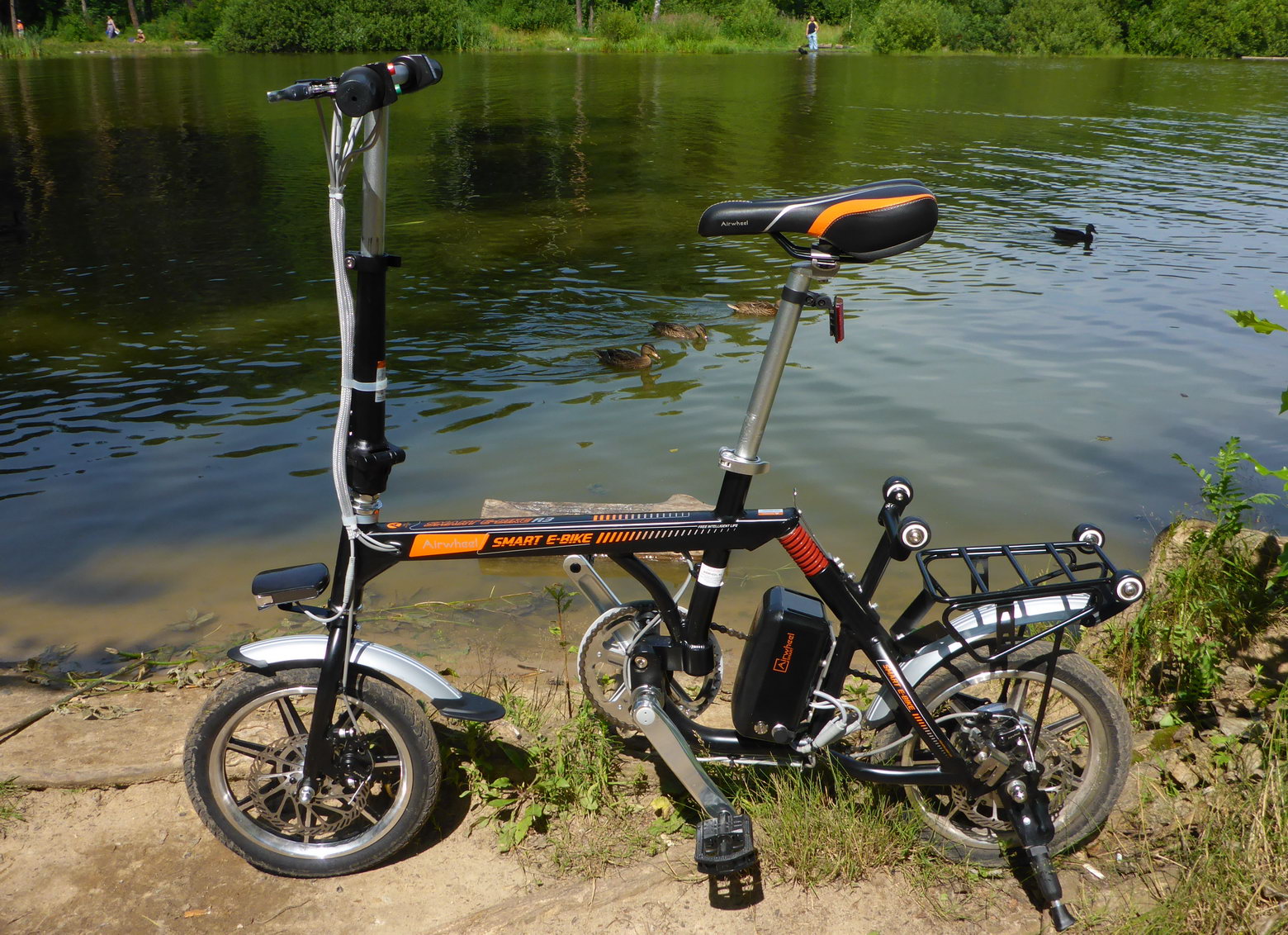
To begin with, the design itself is small, thanks to wheels with a small diameter (14 inches). In addition, the frame can still be folded.
Note the extensive equipment. In addition to the bike itself, it already has the most complete body kit: light, beep, wings, trunk, side folding leg.
By picking there is only one small note. If the front light of a bicycle is a complete headlight, then only a passive red reflector is installed at the rear. For evening and night trips, you will need to purchase a red LED beacon.
In the center of the whole structure is the integrated battery-controller unit:

The photo shows the block from the side of the power button and charging connector. On the opposite side is the USB connector for charging the user's mobile devices from the bicycle battery. It seems that this unit is the same as the model from the previous test (Airwheel R8), but a Bluetooth module has been added to communicate with the smartphone.
And just as this unit can be considered non-removable.
Saddle - medium width, not athletic, but not a “sofa”:

The saddle has adjustments for height, tilt and centering. The alignment must be customized for yourself so that when driving the front or rear edge of the saddle does not fall.
Examine the front wheel:

As noted above, the wheel - cast. This makes it a bit heavier compared to the traditional knitting design; but for life it frees the owner from the operations of adjustment and replacement of the spokes.
Above the wheel is the headlight, combined with the speaker signal. The headlamp shines very well; but because of its low location it shines at an acute angle to the road, because of which the depth of the pits and similar obstacles becomes poorly visible on the road without street lighting. The problem is solved by slowing the speed of the bike to safe.
The sound signal has the same pretensions as the previous bicycle: a too simple beep that is not completely perceived by passersby as a bicycle.
Now examine the back of the bike in the complex:

The most interesting detail here is the trunk with wheels. Immediately you can not guess why they are. The answer is simple, though not obvious: after the bike frame is folded, the bike can be turned over and carried on these wheels, like a travel suitcase.
The motor part of the wheel seems thick, but this is only compared to the wheel itself, which is half the size of the “ordinary” bicycles.
Another very interesting detail is the thick red spring above the battery pack. This is a rear shock absorber that really helps smooth out minor defects on the road; which is especially important in the absence of a shock absorber in the front wheel fork.
Pedals - plastic, folding:

And, at the end of the external inspection, take a look at the steering wheel (right and left):


On the right side of the steering wheel is, in addition to the brake lever, a very simple battery charge indicator of 3 LEDs. If you want to more accurately assess the battery charge, you can do this through the application on your smartphone.
Close to the charge indicator is a ring-shaped regulator of power supplied to the motor.
On the left side of the steering wheel is the front brake knob and two buttons: red - turning on the lights, green - giving a beep.
The bike can be folded, and you can fold the frame and the steering wheel. This is what a folded bicycle looks like in an office interior:

When folded, it takes about as much space as a standard pedestal from an office desk. But this does not negate the need for prior arrangement with the authorities about the storage of a bicycle in the office during the working day.
Driving performance of the Airwheel R3 electric bicycle.
According to the description, the bicycle can move both on the motor and in the help mode (joint work of the motor and the user).
But in fact, this mode of help was not very useful, and here's why.
The bike is single speed and its only speed is slow. At the optimum pedal speed, you can accelerate to 12-14 km / h, no more. It is slow even for the most average cyclist, not to mention the “advanced” ones.
At the same time, the motor can easily accelerate to 20-25 km / h; and then the user, if he starts to rotate the pedals, will turn them in vain, without “catching up” to the motor.
Rotation of the pedals can really help only at the start, uphill and on other heavy roads; which is usually a small part of the journey.
Speaking of speed.
The official data claimed speeds of up to 20 km / h, but in fact, you can accelerate to 25-26 km / h. The secret of this acceleration is in the application for smartphones.
You need to go into the application before the trip and set the maximum, 16th gear (this is how the power levels of the motor are named in the appendix), screenshot: The

installation is valid only for the current ride: after turning off the bike, it goes back to the previous, 15th level (apparently, safety concerns).
Tests were conducted on the range using the optimal strategy of movement, that is: the main movement - on the motor, help with feet on the climbs, the speed of movement - at the 15th level, about 20 km / h.
As a result, the range was 23 km, which confirms the value declared by the manufacturer (20-25 km).
Conclusions on the Airwheel R3 electric bicycle.
Following the results of the inspection and test, three conclusions can be made:
Five models of electric bicycles were considered, and each of them differs significantly in its properties from the others among those considered.
They have a diverse range of options and an even more diverse price; in general, there is an even greater variety of models on the market.
In this situation, the main thing for a potential user is to determine what opportunities he will need from an electric bike. Well, of course, how much money he has in his pocket.
And, of course, before you buy, be sure to get acquainted with the reviews of the model of interest. The variety of models of electric bicycles according to their properties is such that when buying an electric bicycle without “working through the issue”, the consumer can get at all what he had hoped for. Knowledge of technical characteristics alone is not enough to make the right choice.
Thank you all for your attention!
The first part of the review was published here .
Electric bicycles will be considered in descending order of "solidity" of models:
')
- Twitter VS7.0-ER (350 W)
- Airwheel R8 (235 W)
- Airwheel R3 (235 W)
The first model - Twitter electric VS7.0-ER
Traditional note: Twitter electric bikes have nothing to do with the social network Twitter.
The model is a powerful (350 W) electric bicycle with a capacious battery (480 Watt-hours, 48 V * 10 Ah).
Because of its high power, like the Twitter electric bike Mantis-E1, discussed in the first part of the review , according to the classification of traffic regulations, it refers to electric scooters. But it did not affect the appearance.
Let's look at it in general (right and left):


Before further narration, let us familiarize with the main technical parameters of the electric bike:
Wheels - 26 ", double piston rim
Bicycle weight - 19.8 kg
Frame - aluminum, 17 "
Fork - aluminum, damper with the ability to lock.
Gearshifts - Shimano Altus, 27 speeds, (9 * 3)
Brakes - hydraulic disc, Shimano Tourney, mechanical
Tires - Kenda, 26 "× 1.95"
Modes of use - scooter mode, help mode, pedal mode
Drive Parameters:
Number of help mode levels - 5
Battery - Removable, 48 Volt, 10 Amp-hours
Motor - rear wheel motor, brushless, 350 W
Maximum speed - 35 km / h
Mileage on a single charge - 40 km (scooter mode), 120 km (help mode)
Dashboard - LCD Display
Fully all parameters - on the official page of the specifications of the bike .
Bicycle price - 64990 rubles. This price is significantly lower than the more sophisticated Twitter electric bikes discussed in the first part of the review.
This is explained by the more “simple” components on which this bike is built: most of them belong to the initial class of mountain bikes.
At the same time, the electric drive of this bike is no weaker than that of the more expensive models mentioned above. By the way, as mentioned above, according to the traffic regulations, for its high power (> 250 W) it falls into the category of electropaths; although from the side and did not think so.
Let's look at the central part of the bike with a saddle:

The joints of the frame parts between them are smooth, without welds characteristic for welding. The manufacturer calls this “seamless welding” when the traces of welding are carefully smoothed out and become completely invisible.
Saddle - moderately hard, close to sports. You can get used to it.
One of the features of the layout of the electric bike is the separate blocks of batteries and controllers:

The top unit in the photo is a battery (with its own charge controller); and the lower unit (under the frame) is the control unit that controls the electric bike motor.
Due to the fact that the battery pack is removable, it can be charged separately from the bike (the bike can be put in one room and the battery charged in the other).
We will look at the steering wheel of an electric bike in two angles, right and left:


On the right side of the steering wheel, among other things, there is an electric motor power lever. It works smoothly: the more you move it, the more power is supplied to the electric motor, but within the level of assistance that is set by the user.
Thus, the user-defined level of assistance simultaneously controls two characteristics: the actual level of assistance from the motor to the cyclist (when he pedals), and the maximum power level supplied to the motor when the user forcibly turns on the motor (but does not pedal).
On the left side of the steering wheel there is a cycling computer with an LCD screen, combined with a bicycle control panel of three buttons. It sets the level of assistance (from 1 to 5 - "combat" levels, zero level - pedaling without turning on the motor), and also changes the information display modes.
The speed of the electric bike and the battery charge are always displayed; and you can also set the display of the length of the current trip, its duration, or odometer (total mileage).
Look at the front wheel and its fork:


Wheels - universal type, designed for asphalt and ordinary soils (without sand or wet clay).
Accordingly, the brakes, too, although disc, but not from the "cool."
The plug is with a simple damper that is either “on” or “off” (i.e., the plug is fixed). Fork stroke - 100 mm.
The rear wheel of a bicycle is made in the form of a widespread motor-wheel. The motor itself is rather small for its power, and from the side it does not “catch the eye”:

All brakes and speed switches are entry level for mountain bikes.
And finally the pedals. The pedals here are aluminum, thin. They hold the leg well due to the “evil” spike construction:

On the pedals are pins with a rounded top. Despite the fact that the tops are rounded, if you touch the pedal with your foot, you can get hurt. Care must be taken when driving a bicycle next to you.
Electric performance Twitter VS7.0-ER
This electric bike is characterized by the greatest versatility of the modes - it can roll by the force of the motor, the force of the motor together with the power of the catalan, and, of course, only the force of the catalza.
In the help mode, the motor works in the same way as in many other bicycles: it helps the catalas until the power level reaches the limit for the set level of help. And then, if the katalec increases its strength, the power at the motor will decrease.
In this case, if the cyclist wants to go even faster with the help from the motor, then either he should increase the level of help on the console; or, if it was already the highest level of assistance, go skating on your own.
The most interesting question for electric bicycles with the ability to move in scooter mode (only on the motor) is the distance traveled in this mode. Even if such a regime is really rarely used (after all, on a bicycle you want to stretch your legs at least slightly), but such a test is of undoubted “scientific interest”.
So, pumping up the tires well (this increases the efficiency of the bike), I hit the road, choosing better roads (because with well-inflated tires it can be a little painful to drive on bad roads).
The result is just above 65 km (with only 40 km promised by the manufacturer).
The result is excellent, but it can strongly depend on many factors: tire inflation, road quality, weight of the rider and even the weather (headwinds will not contribute to the distance of the trip). Therefore, I will not be enthusiastic about this over measure, but, as a positive fact, I will note.
As for the distance of the trip in mixed mode (motor + legs), there is no doubt about the 120 km indicated by the manufacturer (provided that the cyclist takes up at least 50% of the effort).
A separate question is about speed.
It is possible to achieve the 35 km / h promised by the manufacturer without any efforts (on the motor alone), but the speed can be increased only by our own efforts; and they will have to increase significantly with each additional kilometer of speed.
The number of disadvantages of a bicycle should again include a non-linear graph of battery consumption. At first, the monitor showed a lack of consumption for a long time (charge 100%), and only after a decent trip time did it start to show discharge.
Conclusions on the electric bike Twitter VS7.0-ER
1. The bike has high versatility: you can ride with comfort on the strength of the motor, without a motor, and in mixed mode (legs + motor). This flexibility makes the engine suitable for all lovers of movement on personal electric transport: you can always choose the proportion of application of your own forces, which is convenient for you. Or do not apply forces at all (if you are already tired and rolled).
In addition, the electric bike has a very affordable price for its capabilities.
2. The bike has a powerful motor and a very high range on a single charge. In this regard, it is recommended to use it for extended trips with good speed; and for trips through the parks, the possibilities of the bike will be exaggerated. Although this is not excluded.
We turn to the following models of electric bicycles, already from another manufacturer.
Electric Bike Airwheel R8
This model can also move autonomously, i.e. only the power of the motor; but the help mode and the usual pedal mode are also not excluded.
The main technical parameters of the electric bike:
Wheels - 26 ", double rim
Bicycle weight - 19.5 kg
Frame - Aluminum
Fork - tough
Gear selector (rear only) - Shimano Tourney, 7 speeds
Brakes - disc mechanical
Tires - CST
Modes of use - scooter mode, help mode, pedal mode
Drive Parameters:
Number of levels of help mode - 10
The number of motor power levels - 16
Battery - 36 volts, 162.8 / 214.6 W * h
Motor - motor-wheel, brushless, 235 W
Maximum speed - 27 km / h
Mileage on a single charge - 15-20 km (for 162.8 W * h), 20-25 km (for 214.8 W * h)
Dashboard - LCD Monitor
Fully all parameters - on the official page of the specifications of the bike .
Price - 43490 rubles for a model with a 162.8 Wh battery; 46490 rubles for a model with a battery of 214.6 W * h.
It was only possible to test the maximum model - with a battery of 214.6 Wh.
The appearance of the electric bike on the right and left:


There are unusual details in the design of an electric bike.
The unusual design of the main part of the frame is in the form of a triangular aluminum profile that is curved by a triangle; rear frame feathers are also unusual.
The lower frame feather is thickened, and, apparently, carries the main load.
The upper feather is thinner and is attached to the main frame with bolted joints.
The set of electric bikes already includes lighting - a headlight and a rear red beacon.
The beacon, when it is extinguished, looks like a normal passive reflector. But when it is on, it glows very brightly with several rows of LEDs.
In the center of the whole structure is the integrated battery-controller unit:

The photo shows the block from the side of the power button and charging connector. On the opposite side is the USB connector for charging the user's mobile devices from the bicycle battery.
The battery pack can be considered non-removable (although the manufacturer claims the opposite). You can remove it, but you have to disconnect too many connectors.
Of interest is the saddle:

Orange corrugation on the seatpost can be taken just for decoration. In fact, behind it lies a small damper, partially compensating for the lack of depreciation on the front wheel fork.
In the same photo, you can distinguish the tread pattern on the camera lid. This is a typical poluslik, when the tread in the middle is shallow (for asphalt), and higher on the sides (for soils).
Examine the steering wheel:


On the right side of the steering wheel, most bike controls are assembled.
Here we find the rear brake lever, speed selector lever, remote control with the cycle computer, and the lever for supplying power to the motor.
The left side is less functional, here is the front brake knob, the red light button and the green horn button.
The display shows the distance of the current trip, the current speed, battery charge and the set riding mode. If the assistance level is set to zero, then this is the pedal mode.
I really liked the lighting, but the beep didn’t really.
The loudness of the sound signal is normal, but the sound itself is a usual monotonous beep; and not very similar to the sound of various mechanical bicycle calls (which is confusing passersby - they do not understand what kind of object is coming from behind).
The speaker itself is installed in the same housing with the headlamp:

Holes for sound output from the speaker are located on the back of the headlamp.
The headlamp has a very convex lens that does not allow the light flux to “spread out” in all directions, and shines forward with an optimal angle of scattering.
By the way, the headlight is LED, as it is now accepted.
The front wheel is more than ordinary:

The disc brake is marked as “Airwheel”, so at least partially produced by the bicycle manufacturer itself.
The rear wheel is a traditional motor-wheel:

By the way, I had to tinker a bit with him (or rather, with the frame next to him).
In the test races it turned out that when jumping, even from small curbs, the chain hits the lower frame feather with an unpleasant sound. This problem is often found in different brands of bikes, and there is a standard solution: stick a rubber pad on the feather (it can be seen in the photo).
Before that, I applied the “people's solution” - I wrapped the bottom feather with a ribbon, but this turned out to be not aesthetic.
The last detail of this electric bike, which we will study, is the pedals. They are here - slightly spiny, plastic, but not simple, but folding:

If the pedal is folded, it will help in some cases to reduce the space occupied by the bike in the room.
Road performance of the Airwheel R8
Formally, in this bike, the help mode and the mode of movement on the motor are separated. But this division turned out to be just formal.
In fact, when driving in help mode, it is possible to stop pedaling, and, by pressing the gas lever, ride only on the motor.
The reverse is also possible: in motor mode (in the manual it is called “moped mode”), pedals can be started; and, moreover, twist them for the benefit of the movement and to save battery consumption.
In any case, the motor will help the rider only until it reaches the maximum power for the set mode. And then you will provide all the extra speed on your own.
But it should be noted quite a big step between the highest and the penultimate stage of engine power.
At the penultimate level, you can accelerate, moving only by motor power, up to 20-22 km / h; and at the last (top) level - already up to 27-28 km / h. Perhaps this step is too big.
Were conducted and tests on the course using only the power of the engine, it was 37 km (the manufacturer was modest, saying in the characteristics of only 20-25 km). The tests were carried out, as always, on good roads, with well-inflated tires and at a speed of about 18-20 km / h.
Following the results of the inspection and test of the Airwheel R8, three conclusions can be drawn:
- The bike is quite suitable for traveling on short and medium distances on good roads at speeds of up to 27-28 km / h; at the same time, a wide range of combinations of cyclist power and motor power is possible, including driving only on motor power.
Driving along the ground is also possible, but if the ground is hard and level (of park type). - A variety of applications are possible: trips to work (if there is a safe storage place), walks through parks and to places of rest. With good motor support from the user, trips to neighboring cities and towns are possible.
- The price of an electric bike is quite adequate to its class, especially if you consider the pre-installed lighting equipment (it also costs money).
We turn to the next model manufacturer Airwheel.
E-bike Airwheel R3
If the previous two models of electric bicycles could be classified as “for the lazy”, then this model can be classified as for the “very lazy”. Why - will be explained further.
The main technical parameters of the electric bike:
Wheels - 14 ", cast, aluminum
Bicycle weight - 17 kg
Frame - aluminum, foldable, with shock absorption
The number of speeds - 1
Fork - tough
Brakes - disc mechanical
Modes of use - scooter mode, help mode, pedal mode
Drive Parameters:
Battery - 36 volts, / 214 W * h
Motor - motor-wheel, brushless, 235 W
Maximum speed - 20 km / h (25 km / h when setting the maximum in the application)
Mileage on a single charge –20-25 km
Dashboard - LED battery charge indicator
Software: application for Android and iOS.
Fully all parameters - on the official page of the specifications of the bike .
Price - 37490 rubles (in some stores may be more expensive).
The appearance of the electric bike on the right and left:


To begin with, the design itself is small, thanks to wheels with a small diameter (14 inches). In addition, the frame can still be folded.
Note the extensive equipment. In addition to the bike itself, it already has the most complete body kit: light, beep, wings, trunk, side folding leg.
By picking there is only one small note. If the front light of a bicycle is a complete headlight, then only a passive red reflector is installed at the rear. For evening and night trips, you will need to purchase a red LED beacon.
In the center of the whole structure is the integrated battery-controller unit:

The photo shows the block from the side of the power button and charging connector. On the opposite side is the USB connector for charging the user's mobile devices from the bicycle battery. It seems that this unit is the same as the model from the previous test (Airwheel R8), but a Bluetooth module has been added to communicate with the smartphone.
And just as this unit can be considered non-removable.
Saddle - medium width, not athletic, but not a “sofa”:

The saddle has adjustments for height, tilt and centering. The alignment must be customized for yourself so that when driving the front or rear edge of the saddle does not fall.
Examine the front wheel:

As noted above, the wheel - cast. This makes it a bit heavier compared to the traditional knitting design; but for life it frees the owner from the operations of adjustment and replacement of the spokes.
Above the wheel is the headlight, combined with the speaker signal. The headlamp shines very well; but because of its low location it shines at an acute angle to the road, because of which the depth of the pits and similar obstacles becomes poorly visible on the road without street lighting. The problem is solved by slowing the speed of the bike to safe.
The sound signal has the same pretensions as the previous bicycle: a too simple beep that is not completely perceived by passersby as a bicycle.
Now examine the back of the bike in the complex:

The most interesting detail here is the trunk with wheels. Immediately you can not guess why they are. The answer is simple, though not obvious: after the bike frame is folded, the bike can be turned over and carried on these wheels, like a travel suitcase.
The motor part of the wheel seems thick, but this is only compared to the wheel itself, which is half the size of the “ordinary” bicycles.
Another very interesting detail is the thick red spring above the battery pack. This is a rear shock absorber that really helps smooth out minor defects on the road; which is especially important in the absence of a shock absorber in the front wheel fork.
Pedals - plastic, folding:

And, at the end of the external inspection, take a look at the steering wheel (right and left):


On the right side of the steering wheel is, in addition to the brake lever, a very simple battery charge indicator of 3 LEDs. If you want to more accurately assess the battery charge, you can do this through the application on your smartphone.
Close to the charge indicator is a ring-shaped regulator of power supplied to the motor.
On the left side of the steering wheel is the front brake knob and two buttons: red - turning on the lights, green - giving a beep.
The bike can be folded, and you can fold the frame and the steering wheel. This is what a folded bicycle looks like in an office interior:

When folded, it takes about as much space as a standard pedestal from an office desk. But this does not negate the need for prior arrangement with the authorities about the storage of a bicycle in the office during the working day.
Driving performance of the Airwheel R3 electric bicycle.
According to the description, the bicycle can move both on the motor and in the help mode (joint work of the motor and the user).
But in fact, this mode of help was not very useful, and here's why.
The bike is single speed and its only speed is slow. At the optimum pedal speed, you can accelerate to 12-14 km / h, no more. It is slow even for the most average cyclist, not to mention the “advanced” ones.
At the same time, the motor can easily accelerate to 20-25 km / h; and then the user, if he starts to rotate the pedals, will turn them in vain, without “catching up” to the motor.
Rotation of the pedals can really help only at the start, uphill and on other heavy roads; which is usually a small part of the journey.
Speaking of speed.
The official data claimed speeds of up to 20 km / h, but in fact, you can accelerate to 25-26 km / h. The secret of this acceleration is in the application for smartphones.
You need to go into the application before the trip and set the maximum, 16th gear (this is how the power levels of the motor are named in the appendix), screenshot: The

installation is valid only for the current ride: after turning off the bike, it goes back to the previous, 15th level (apparently, safety concerns).
Tests were conducted on the range using the optimal strategy of movement, that is: the main movement - on the motor, help with feet on the climbs, the speed of movement - at the 15th level, about 20 km / h.
As a result, the range was 23 km, which confirms the value declared by the manufacturer (20-25 km).
Conclusions on the Airwheel R3 electric bicycle.
Following the results of the inspection and test, three conclusions can be made:
- The bike is quite suitable for trips over short distances on good roads at speeds of up to 25-26 km / h; while the main movement will be carried out on the strength of the motor, and the cyclist will be able to help him only sporadically.
Driving along the ground is also possible, but if the ground is hard and level (of park type). - Possible applications: trips to work (with its fairly close location), walks through parks and to places of rest.
- Particularly worth mentioning extensive equipment (and it costs money, and not to say that small).
Final conclusions on the tests of five models of electric bikes
Five models of electric bicycles were considered, and each of them differs significantly in its properties from the others among those considered.
They have a diverse range of options and an even more diverse price; in general, there is an even greater variety of models on the market.
In this situation, the main thing for a potential user is to determine what opportunities he will need from an electric bike. Well, of course, how much money he has in his pocket.
And, of course, before you buy, be sure to get acquainted with the reviews of the model of interest. The variety of models of electric bicycles according to their properties is such that when buying an electric bicycle without “working through the issue”, the consumer can get at all what he had hoped for. Knowledge of technical characteristics alone is not enough to make the right choice.
Thank you all for your attention!
Source: https://habr.com/ru/post/458728/
All Articles